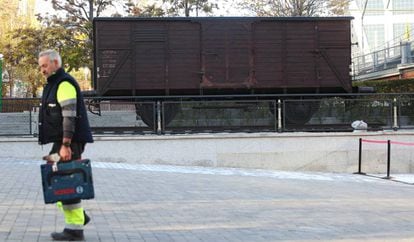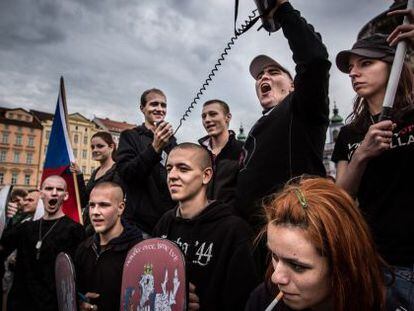Hate campaign strikes major Auschwitz exhibition in Madrid
The comprehensive event has received many anti-Semitic threats before its inauguration


The most elaborate traveling exhibition about the Nazi concentration camp Auschwitz ever put together has been subject to an onslaught of anti-Semitic sentiment after the Spanish company Musealia advertised its inauguration on December 1, at the Canal Art Center in Madrid.
On show until June 2018, the exhibition consists of objects from the notorious concentration camp and carries the strong message that there is nothing to stop the same thing happening again under a different guise with the reminder: “Not long ago, not far away.”
The anti-Semitism on the internet now is not that different to the anti-Semitism of the 1930s Icíar Palacios, Musealia
“We were prepared for all sorts of responses but we didn’t think there would be so many [of this nature],” says Icíar Palacios, the press officer for Musealia, a company based in San Sebastian, which has reported the online perpetrators to the Spanish government’s counter-radicalization center, the CCIR, while also filing a complaint with Twitter and Facebook.
Musealia was warned by the exhibition’s co-producers, the Auschwitz-Birkenau State Museum, that they would receive hate-fueled feedback, but that rather than respond, they should simply report and block.
The social media comments range from outright denial of the existence of the gas chambers or the validity of the diary of Anne Frank – which documents the experiences of a young German-born Jewish girl in hiding from the Nazis in an Amsterdam house – to anti-Semitic conspiracy theories such as world domination by the Jewish community and Jewish media control.

“The anti-Semitism that is common on the internet now is not that different in content to the ant-Semitism of the 1930s,” says Palacios. “There’s a lot of white supremacist propaganda around, many conspiracy theories and a lot of typical anti-Jewish remarks.”
On November 11, 60,000 far-right extremists from across Europe congregated in Warsaw, demanding ethnic cleansing against a backdrop of multiplying anti-Semitic crimes in countries such as Hungary. The main target for the hatred at the Warsaw march was the Muslim community, though anti-Semitic sentiment was also apparent.
Should we be worried? The social climate in which intolerance is on parade in the streets of a European capital is what prompted the organizers to mount the exhibition. After all, the extermination of six million Jews did not take place in a vacuum, but at a particularly delicate moment in Europe’s history.
It starts with tweets and ends with an attack on a school or synagogue Isaac Querub, Jewish Communities president
Experts on racial hatred are caught between the need to condemn such demonstrations and the dangers of giving the haters a greater voice. They may be eaten up by hatred but in the scheme of things their numbers are still negligible.
In the case of Spain, Isaac Querub, President of the Federation for Jewish Communities in Spain, insists the country is not anti-Semitic, although the social media posts are cause for concern. “It starts with tweets and ends with an attack on a school or synagogue,” he says.
Meanwhile, according to an expert on hate crimes in the Spanish Civil Guard, “When an event departs from the norm such as this exhibition, there is always a rash of comments. People imagine that social media means anonymity but denial can still be a crime.”
Statistics on hate crimes from the Spanish Home Office reveal that anti-Semitism accounts for a small number of such crimes in Spain – a mere 0.6% in 2016. The situation in Europe, however, is quite different. The European Agency for Fundamental Rights (FRA) has just published a report on ant-Semitism that claims it “represents a serious problem”. A 2014 FRA study revealed that 26% of European Jews had suffered physical or verbal abuse at some stage in their lives.
Denial
The head curator of the Madrid exhibition is the author of The Case for Auschwitz, Robert Jan Van Pelt. He was involved in the libel case against US historian Deborah E. Lipstadt brought by British historian David Irving for describing him as “a denier” in her writing. The case was made into the 2016 movie Denial with Rachel Weisz, and Van Pelt’s report on the case is considered a milestone in the fight against denial.
People imagine that social media means anonymity but denial can still be a crime Spanish Civil Guard
“I have spent 30 years working in this area and Auschwitz attracts deniers,” says the Dutch historian who now lives in Toronto. “If you search for Auschwitz on Google, you have pages of this rubbish coming up. The main thing is not to compare narratives. You can’t argue with these people because their arguments aren’t rational. What we are doing with this exhibition is establishing the facts and putting solid evidence on display. We want to attract young people so that, for two hours, they emerge from the swamp of information they are immersed in to focus purely on that.”
Höss’ desk
Luis Ferreiro, director of Musealia, was moved to mount the Auschwitz exhibition after reading Man's Search for Meaning by Holocaust survivor Viktor Frankl. "It made me think I would like to see an exhibition on the concentration camp and its historical repercussions," he explains.
He set to work on the project in 2009, collaborating with 20 institutions, above all the Auschwitz-Birkenau State Museum. The exhibition includes a train carriage and a section of a bunkhouse from Auschwitz III-Monowitz – the satellite camp where Italian Holocaust survivor and writer Primo Levi was held – as well as numerous elements from the camp that tell the story of both the victims and the SS concentration camp guards, among them the longest-serving commandant of Auschwitz, Rudolf Höss, who was executed in 1947, after acknowledging the enormity of his crimes.
The exhibition will be on the move for seven years with the Swedish city of Malmö it’s next port of call after Madrid, followed by Amsterdam and a number of cities in the US.
English version by Heather Galloway.












































